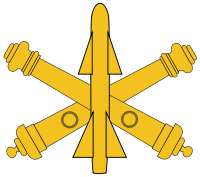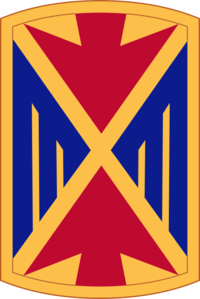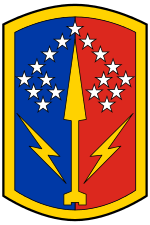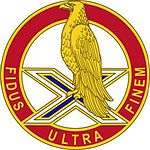Air Defense Artillery Branch (United States)
| Air Defense Artillery branch | |
|---|---|
|
Branch plaque | |
| Active | 1968-present |
| Country | United States |
| Branch | U.S. Army |
| Type | Branch |
| Role | Air and Missile Defense |
| Nickname(s) | Emperor of Battle |
| Motto(s) | "First to Fire" |
| Colors | Red and Gold |
| March | ADA March |
| Mascot(s) | Oozlefinch |
| Anniversaries | 17 November 1775- The Continental Congress elected Henry Knox "Colonel of the Regiment of Artillery"[1] |
| Insignia | |
| Branch insignia |
 |
The Air Defense Artillery branch of the US Army specializes in anti-aircraft weapons (such as surface to air missiles). In the US Army, these groups are composed of mainly air defense systems such as the Patriot Missile System, Terminal High Altitude Area Defense (THAAD), and the Avenger Air Defense system which fires the FIM-92 Stinger missile. The Air Defense Artillery branch descended from Anti-Aircraft Artillery (part of the U.S. Army Coast Artillery Corps until 1950, then part of the Artillery Branch) into a separate branch on 20 June 1968. On 1 December 1968, the ADA branch was authorized to wear modified Artillery insignia, crossed field guns with missile.
Mission
According to the Army's Field Manual 44-100, the mission of Air Defense Artillery is "to protect the force and selected geopolitical assets from aerial attack, missile attack, and surveillance."[2]
History
On 10 October 1917 an Antiaircraft Service in the American Expeditionary Force (AEF) was created at Arnouville-Les-Gonesse where an antiaircraft school was established. The antiaircraft units were organized as serially numbered battalions during the war, as follows:
- 1st Antiaircraft Battalion through the 10th Antiaircraft Battalion
- 1st AA Machine Gun Battalion through the 6th AA Machine Gun Battalion. These units were organized by Col. James A. Shipton[3] but were disbanded in May 1918.
- The National Defense Act of 1920 formally assigned the air defense mission to the Coast Artillery Corps, and 4 battalions were organized in 1921. In 1924 under a major reorganization of the Coast Artillery the battalions were reorganized as regiments.[4][5]
- (6) Anti-aircraft regiments
- 60th Coast Artillery (AA)
- 61st Coast Artillery (AA)
- 62nd Coast Artillery (AA)
- 63rd Coast Artillery (AA)
- 64th Coast Artillery (AA)
- 65th Coast Artillery (AA)
- (13) National Guard
- 197th Coast Artillery (AA) N.H.
- 198th Coast Artillery (AA) DE.
- 200th Coast Artillery (AA) N.M.
- 202nd Coast Artillery (AA) IL.
- 203rd Coast Artillery (AA) MO.
- 206th Coast Artillery (AA) AR.
- 207th Coast Artillery (AA) N.Y. ?
- 211th Coast Artillery (AA) MA.
- 212th Coast Artillery (AA) N.Y.
- 213th Coast Artillery (AA) PA.
- 214th Coast Artillery (AA) GA. ?
- 251st Coast Artillery (AA) CA.[6]
- 369th Coast Artillery (AA) N.Y.
In 1938 there were only 5 Regular Army and thirteen National Guard regiments, but by 1941 this had been expanded to 37 total regiments. In November 1942, 781 battalions were authorized. However, this number was pared down to 331 battalions by the end of the war. By late 1944 the regiments had been broken up into battalions and 144 "Antiaircraft Artillery Groups" had been activated; some of these existed only briefly.[7]
On 9 March 1942 Antiaircraft Command was established in Washington D.C. and in 1944 the AAA school was moved to Fort Bliss.
Army Anti-Aircraft Command
Army Anti-Aircraft Command (ARAACOM) was created on 29 June 1950. The Army formed it to command the Army units allocated to the air defense of the Continental United States. ARAACOM was also charged with becoming the Army component of a joint continental defense force, if and when the joint force was designated. Eastern and Western Army Antiaircraft Commands were established with HQ at Stewart AFB, New York, and Hamilton AFB, California, on 1 September 1950. Anti-Aircraft Command moved to Mitchel Air Force Base, New York on 1 November 1950.
On 10 April 1951, the Commanding General assumed command of all AAA units allocated to continental air defense—six AW, nine 90-mm. and eight 120-mm. battalions plus four brigade and seven Gp HQ, eight AAA Ops Det and 15 Signal radar detachments. On 24 April Central Army Anti-Aircraft Command was established with HQ at Kansas City, Missouri. It was organized 1 May 1951. By 31 December controlling formations had grown to six brigades and 13 group headquarters. On 31 May 1955 EARAACOM was disestablished and personnel assigned to the 1st AAA Region.[8]
In 1955, numbering started to replace geographic locations to designate regions.[9] The 1st, 2nd and 5th Regions (plus the 53rd Artillery Brigade) now covered the area once called Eastern ARAACOM. In 1956, Western ARAACOM became 6th Region, and the following year, Central became the 4th Region. Areas of responsibility between regions and brigades continued to shift throughout the life of the command.
On March 21, 1957, ARAACOM was renamed to US Army Air Defense Command (USARADCOM).
On 26 July 1960, ARADCOM activated a sixth region.
By 1966 regions and headquarters were as follows:
- 1st Region - Fort Totten, New York. Moved to Stewart AFB, NY around 1966. The 17th Artillery Group defended Baltimore, Maryland, from 1952. The 56th Air Defense Artillery Brigade, at Fort Totten and then Fort Devens, controlled the Providence and Boston air defense battalions, a total of five. The 11th Artillery Group, activated in May 1955 at Camp Stewart, GA., controlled the Savannah River Defense Area from its arrival in May 1958. The Defense Area included 33, 425, and 478 AAA Battalions, though the 478 deactivated 15 Feb 1958, and the other two battalions appear to have possibly fused into 4th Battalion, 7th Air Defense Artillery Regiment, on 1 September 1958.[10] The 11th Artillery Group deactivated August 1960 seemingly at Rehoboth.
- 2d ARADCOM Region - Richards-Gebaur AFB, Missouri. The 2nd ARADCOM Region was activated on 1 March 1951 at Fort George G. Meade, MD, and inactivated on 30 June 1971.[11] At Oklahoma City Air Force Station, 9/63, Richards-Gebaur (12/69), and then Selfridge Air Force Base. 35th Air Defense Artillery Brigade controlled the Washington DC defenses from Fort Meade until it was deactivated in December 1973. Thereafter the 23rd Air Defense Artillery Group stood watch from Meade until 1 September 1974. The Group had previously been part of the New York defenses, and before that, a field artillery group in Long Binh, South Vietnam.[12]
- 5th Region - Fort Sheridan, Illinois. The 45th Artillery Brigade controlled the Chicago-Gary Defense Area (10 missile batteries and their Integrated Fire Control sites) from the Arlington Heights Army Air Defense Site.[13][14] 5th Region moved to Maxwell AFB, AL, early 1966. 5th Battalion, 562nd Air Defense Artillery Regiment, maintained the Barksdale Defense Area until 1966.
- 6th Region - Fort Baker, California. Activated as WARAACOM in September 1950. To Fort Baker in 1951, according to Rings of Supersonic Steel (p. 153). Disestablished 1 August 1974. The 40th Artillery Brigade (AD) was established on 23 January 1959 at Fort Barry, moved to Fort Winfield Scott, and deactivated 23 January 1971. The 114th Artillery Brigade (AD) (CA ARNG) was active between 1959 and 1963, along with the 233rd Artillery Group, both in San Francisco. The 13th Artillery Group, which replaced the 40th Brigade in the Bay Area, was activated in March 1958 at Fort Stewart, GA., deployed to southwest Miami, moved to Homestead AFB in November 1968, Snelling Air Force Station (June 1971), and then the Presidio of San Francisco, where it appears to have deactivated on 1 August 1974.[15]
- 7th Region - McChord Air Force Base, Washington (July 1960 to 1 April 1966). 31st Air Defense Artillery Brigade, at McChord AFB, transferred to Lockport Air Force Station, NY, in December 1961. Also present were HQ 26th Artillery Group (AD) (12/61-3/66) at Fort Lawton which replaced the 31st Brigade when it moved, and HQ 49th ADA Group (3/66-8/74). With the 7th ARADCOM Region being disbanded on 1 April 1966, the areas of responsibility of the 1st, 2nd, 5th, and 6th ARADCOM Regions were reorganized.[16] The 115th Artillery Brigade (Air Defense) was a corresponding Washington Army National Guard formation.
The NORAD-CONAD History for the first part of 1965 says that the 53d Brigade Headquarters was to move from Maxwell AFB to McChord AFB and the personnel of the discontinued 7th Region transferred to it. The personnel of the 53rd at Maxwell AFB were to be transferred to the 5th Region. The 1st Region Headquarters was also moving from Fort Totten, NY, to Stewart AFB, NY, because Fort Totten was being closed.
On 1 August 1966, Lieutenant General Robert Hackett assumed command of the United States Army Air Defense Command at Ent Air Force Base in Colorado Springs, Colorado, an assignment he held until he retired 30 June 1968.
The serially numbered battalions bore the following titles
- Antiaircraft Artillery Battalion
- Antiaircraft Artillery Automatic Weapons Battalion
- Antiaircraft Artillery Gun Battalion
- Antiaircraft Artillery Searchlight Battalion
- Barrage balloon Battalions
and later
- Antiaircraft Artillery Missile Battalion.
In 1957 the Combat Arms Regimental System organized the battalions under regiments again. In 1968 the Air Defense Artillery Branch was created.
ARADCOM strength peaked in 1963, with 184 firing units (134 Regular Army, 50 National Guard). However, beginning in September 1968, the command was reduced in strength. On February 4, 1974, the U.S. Department of Defense announced that ARADCOM would be inactivated, apart from the 31st Air Defense Artillery Brigade, which had been activated during the Cuban Missile Crisis (October 1962) and would remain on duty in southern Florida. By December 31, 1974, ARADCOM's remaining regional headquarters, eight groups, 13 battalion headquarters, and 48 Hercules firing batteries were closed out. ARADCOM headquarters was inactivated January 4, 1975.
In 2010 the United States Army Air Defense Artillery School was moved from Fort Bliss to Fort Sill.
Major commands
| Command | SSI | Garrison | Subordinate to/ corps or army |
|---|---|---|---|
| 32nd Army Air & Missile Defense Command |  |
Fort Bliss, TX | FORSCOM |
| 94th Army Air & Missile Defense Command |  |
Fort Shafter, HI | United States Army Pacific |
| 10th Army Air & Missile Defense Command |  |
Kaiserslautern, Germany | United States Army Europe |
| 263rd Army Air & Missile Defense Command |  |
Anderson, SC | South Carolina Army National Guard |
Brigade size units

| Brigade | SSI | Subordinate to/ garrison | Component |
|---|---|---|---|
| 30th ADA Brigade (ADA School) |  |
Fort Sill | Training and Doctrine Command |
| 11th ADA Brigade |  |
Fort Bliss | 32nd Army Air & Missile Defense Command |
| 31st ADA Brigade |  |
Fort Sill | 32nd Army Air & Missile Defense Command |
| 35th ADA Brigade |  |
South Korea | Eighth United States Army / 94th Army Air & Missile Defense Command[17] |
| 69th ADA Brigade |  |
Fort Hood | 32nd Army Air & Missile Defense Command |
| 108th ADA Brigade |  |
Fort Bragg Fort Campbell |
32nd Army Air & Missile Defense Command |
| 164th ADA Brigade |  |
Florida ARNG | |
| 174th ADA Brigade |  |
Ohio ARNG | |
Battalions
| Unit | DUI | Subordinate to/ garrison | Component |
|---|---|---|---|
| 1-1 ADA 2-1 ADA |
35th ADA Brigade | Regular Army | |
| A Battery, 2nd ADA 3-2 ADA |
 |
11th ADA Brigade (A Battery, 2nd ADA) 31st ADA Brigade, Fort Sill (3-2 ADA) |
Regular Army |
| 4-3 ADA |  |
31st ADA Brigade, Fort Sill | Regular Army |
| A Battery, 4th ADA 3–4 ADA |
11th ADA Brigade (A Battery, 4th ADA) 108th ADA Brigade (3–4 ADA) |
Regular Army | |
| 4-5 AMD 5-5 ADA |
 |
69th ADA Brigade (4–5 AMD) 31st ADA Brigade (5–5 ADA) |
Regular Army |
| 2–6 ADA 3–6 ADA |
6th ADA Brigade (ADA School), Fort Sill | Regular Army | |
| 1-7 ADA (P) 5-7 ADA (P) |
108th ADA Brigade (1–7 ADA) Kaiserslautern, Germany (5–7 ADA) |
Regular Army | |
| 1–43 ADA 2–43 ADA 3–43 ADA |
 |
11th ADA Brigade | Regular Army |
| 1–44 ADA 2–44 ADA |
 |
69th ADA Brigade (1–44th ADA) Fort Hood 108th ADA Brigade (2–44 ADA) |
Regular Army |
| 5–52 ADA 6–52 ADA |
 |
11th ADA Brigade (5–52) 35th ADA Brigade (6–52) |
Regular Army |
| 1–56 ADA |  |
6th ADA Brigade (ADA School), Fort Sill | Regular Army |
| 1–62 ADA |  |
69th ADA Brigade, Fort Hood | Regular Army |
| 1–204 ADA |  |
174th ADA Brigade, Ohio ARNG | Mississippi ARNG |
Shipton award
The Shipton Award is named for Brigadier General James A. Shipton, who is acknowledged as the Air Defense Artillery Branch's founding father.[18] Shipton felt that the mission of antiaircraft defense was not to down enemy aircraft, but instead to protect maneuver forces on the ground: "The purpose of anti-aviation defense is to protect our own forces and establishments from hostile attack and observation from the air by keeping enemy aeroplanes [sic] at a distance." The Shipton Award recognizes an Air Defense Artillery professional for outstanding performance individual thought, innovation and contributions that results in significant contributions or enhances Air Defense Artillery's warfighting capabilities, morale, readiness and maintenance.
See also
- Coats of arms of U.S. Air Defense Artillery Regiments
- Fort Bliss
- Fort Sill
- JLENS
- M163 VADS
- M167 Vulcan
- MIM-104 Patriot
- THAAD
- Saint Barbara
- Oozlefinch
- Nike Hercules
- MIM-23 Hawk
References
- ↑ TIOH Air Defense Artillery branch page
- ↑ FM 44-100
- ↑ Biographical Register of the Officers and Graduates of the U.S. Military Academy at West Point, N.Y.
- ↑ Berhow, pp. 437-442
- ↑ Coast Artillery Regiments at CDSG
- ↑ Bob MacDonald. "We Aim to Hit". California State Military Museum. California State Military Department. Retrieved 28 January 2012.
- ↑ Stanton, pp. 434-481
- ↑ Volume 1, 232
- ↑ Vigilant and Invincible
- ↑ Morgan and Berhow, 160.
- ↑ Rings of Supersonic Steel, 173.
- ↑ Morgan and Berhow, 173.
- ↑ Freeman, Paul (June 4, 2011) [2002]. "Abandoned & Little-Known Airfields: Illinois, Northwestern Chicago area". Abandoned & Little-Known Airfields. Archived from the original on 22 June 2011.
On April 6, 1959, BG Peter Schmick, Brigade CG, announced the purchase of the land,along with plans for the construction of the [Army] Command Post, 5 radar towers and supporting buildings… The official dedication…was made on October 28, 1960.
- ↑
- ↑ Mark L. Morgan, Mark A. Berhow, Rings of Supersonic Steel: Air Defenses of the United States Army 1950-1979, 153.
- ↑ Barry Leonard (ed.), History of Strategic and Ballistic Missile Defense: Volume II: 1956-1972, 317
- ↑ http://www.usarpac.army.mil/94AAMDC/Leaders/Leadership%20Page.htm. Retrieved 13 February 2012. Missing or empty
|title=(help) - ↑ Stiller, Jesse H. (2010). "ADA Branch: A Proud Heritage" (PDF). Air Defense Artillery Online. Archived from the original (PDF) on 29 July 2014.
- Antiaircraft Artillery Battalions of the U.S. Army (Volumes 1,2) 1991 by James A. Sawicki ISBN 0-9602404-7-0
- http://freepages.military.rootsweb.ancestry.com/~cacunithistories/1st_AA_Bn_CAC.html
- Berhow, Mark A., Ed. (2004). American Seacoast Defenses, A Reference Guide, Second Edition. CDSG Press. ISBN 0-9748167-0-1.
- Lieutenant Colonel Roy S. Barnard (The History of ARADCOM Volume I, The Gun Era:1950-1955)
- LTC Barnard and Berle K. Hufford, ARADCOM Annual Reports from 1966-1973.
- Lieutenant Colonel Timothy Osato, Militia Missilemen: The Army National Guard in Air Defense - 1951 - 1967 (1968)
- Osato and Mrs. Sherryl Straup, ARADCOM's Florida Defenses in the Aftermath of the Cuban Missile Crisis: 1963-1968 (1968)
- Stanton, Shelby L. (1991). World War II Order of Battle. Galahad Books. ISBN 0-88365-775-9.
External links
- http://www.history.army.mil/html/forcestruc/lineages/branches/ada/default.htm
- ADA museum-
- http://www.ftmac.org/Lanike2.htm - 47th Brigade at Fort McArthur, Calif.
- some details on U.S. Army Air Defense Command (ARADCOM)
